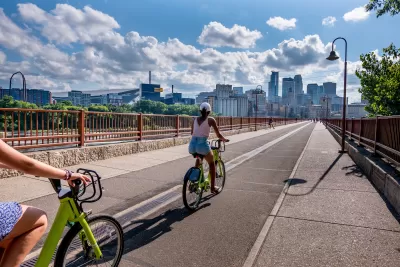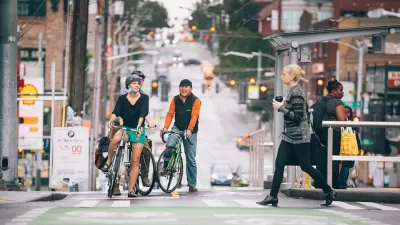PeopleForBikes has evaluated bike networks in thousands of cities across the United States and identified several that have achieved “incredible increases” in just a few years.

According to a recent article on PeopleforBikes.org, “Each year, PeopleForBikes’ City Ratings program evaluates thousands of communities worldwide on the quality of their low-stress bike networks through our Bicycle Network Analysis (BNA).
City Ratings data has revealed that 39 cities in the United States boosted their scores by at least 20 points between 2020 and 2024 through policy changes like Complete Street mandates, lower speed limits, and increased state and local funding, as well as implementation of strategies like protected bike lanes, reallocated space, intersection treatments, network connections, and data.
So which cities have earned the title of “most-improved bike network” between 2020 and 2024?
- Minneapolis, Minnesota (54-point increase)
- Saint Paul, Minnesota (52-point increase)
- Jackson, Wyoming (48-point increase)
- Bloomington, Indiana (45-point increase)
- Aurora, Illinois (40-point increase)
- St. Louis Park, Minnesota (40-point increase)
- Corvallis, Oregon (39-point increase)
- Key West, Florida (39-point increase)
- Coeur D'Alene, Idaho (39-point increase)
- Somerville, Massachusetts (38-point increase)
- Cambridge, Massachusetts (37-point increase)
For details on how these cities improved their scores, and for an impressive list of honorable mentions, check out the original article below.
FULL STORY: 2024’s Most Improved Cities for Biking

Alabama: Trump Terminates Settlements for Black Communities Harmed By Raw Sewage
Trump deemed the landmark civil rights agreement “illegal DEI and environmental justice policy.”

Planetizen Federal Action Tracker
A weekly monitor of how Trump’s orders and actions are impacting planners and planning in America.

The 120 Year Old Tiny Home Villages That Sheltered San Francisco’s Earthquake Refugees
More than a century ago, San Francisco mobilized to house thousands of residents displaced by the 1906 earthquake. Could their strategy offer a model for the present?

In Both Crashes and Crime, Public Transportation is Far Safer than Driving
Contrary to popular assumptions, public transportation has far lower crash and crime rates than automobile travel. For safer communities, improve and encourage transit travel.

Report: Zoning Reforms Should Complement Nashville’s Ambitious Transit Plan
Without reform, restrictive zoning codes will limit the impact of the city’s planned transit expansion and could exclude some of the residents who depend on transit the most.

Judge Orders Release of Frozen IRA, IIJA Funding
The decision is a victory for environmental groups who charged that freezing funds for critical infrastructure and disaster response programs caused “real and irreparable harm” to communities.
Urban Design for Planners 1: Software Tools
This six-course series explores essential urban design concepts using open source software and equips planners with the tools they need to participate fully in the urban design process.
Planning for Universal Design
Learn the tools for implementing Universal Design in planning regulations.
Clanton & Associates, Inc.
Jessamine County Fiscal Court
Institute for Housing and Urban Development Studies (IHS)
City of Grandview
Harvard GSD Executive Education
Toledo-Lucas County Plan Commissions
Salt Lake City
NYU Wagner Graduate School of Public Service




























